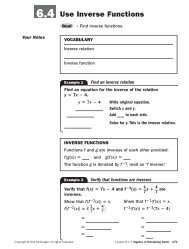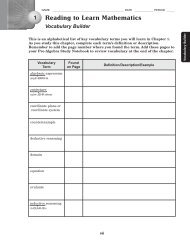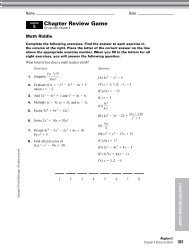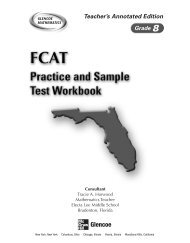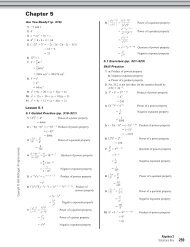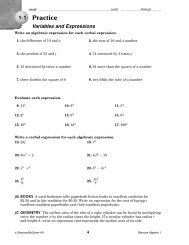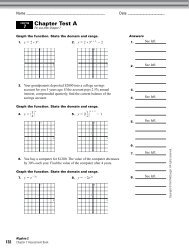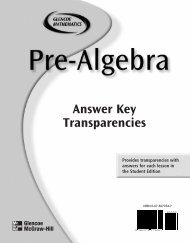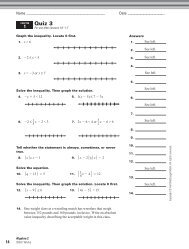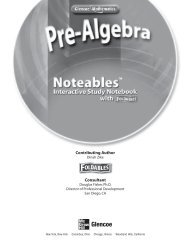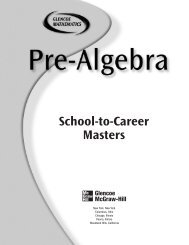Study Guide and Intervention (continued) - MathnMind
Study Guide and Intervention (continued) - MathnMind
Study Guide and Intervention (continued) - MathnMind
Create successful ePaper yourself
Turn your PDF publications into a flip-book with our unique Google optimized e-Paper software.
3-4<br />
NAME ______________________________________________ DATE ____________ PERIOD _____<br />
<strong>Study</strong> <strong>Guide</strong> <strong>and</strong> <strong>Intervention</strong><br />
Solving Multi-Step Equations<br />
Work Backward Working backward is one of many problem-solving strategies that<br />
you can use to solve problems. To work backward, start with the result given at the end of a<br />
problem <strong>and</strong> undo each step to arrive at the beginning number.<br />
Example 1 Example 2<br />
A number is divided<br />
by 2, <strong>and</strong> then 8 is subtracted from<br />
the quotient. The result is 16. What<br />
is the number?<br />
Solve the problem by working backward.<br />
The final number is 16. Undo<br />
subtracting 8 by adding 8 to get 24. To<br />
undo dividing 24 by 2, multiply 24 by 2<br />
to get 48.<br />
The original number is 48.<br />
Exercises<br />
Solve each problem by working backward.<br />
A bacteria culture doubles<br />
each half hour. After 3 hours, there are<br />
6400 bacteria. How many bacteria were<br />
there to begin with?<br />
Solve the problem by working backward.<br />
The bacteria have grown for 3 hours. Since there<br />
are 2 one-half hour periods in one hour, in 3 hours<br />
there are 6 one-half hour periods. Since the<br />
bacteria culture has grown for 6 time periods, it<br />
has doubled 6 times. Undo the doubling by<br />
halving the number of bacteria 6 times.<br />
1 1 1 1 1 1<br />
1<br />
6,400 6,400 <br />
2 2 2 2 2 2<br />
64<br />
100<br />
There were 100 bacteria to begin with.<br />
1. A number is divided by 3, <strong>and</strong> then 4 is added to the quotient. The result is 8. Find the<br />
number.<br />
2. A number is multiplied by 5, <strong>and</strong> then 3 is subtracted from the product. The result is 12.<br />
Find the number.<br />
3. Eight is subtracted from a number, <strong>and</strong> then the difference is multiplied by 2. The result<br />
is 24. Find the number.<br />
4. Three times a number plus 3 is 24. Find the number.<br />
5. CAR RENTAL Angela rented a car for $29.99 a day plus a one-time insurance cost of<br />
$5.00. Her bill was $124.96. For how many days did she rent the car?<br />
6. MONEY Mike withdrew an amount of money from his bank account. He spent one<br />
fourth for gasoline <strong>and</strong> had $90 left. How much money did he withdraw?<br />
7. TELEVISIONS In 1999, 68% of households with TV’s subscribed to cable TV. If 8,000 more<br />
subscribers are added to the number of households with cable, the total number of<br />
households with cable TV would be 67,600,000. How many households were there with<br />
TV in 1999? Source: World Almanac<br />
© Glencoe/McGraw-Hill 155 Glencoe Algebra 1<br />
Lesson 3-4



